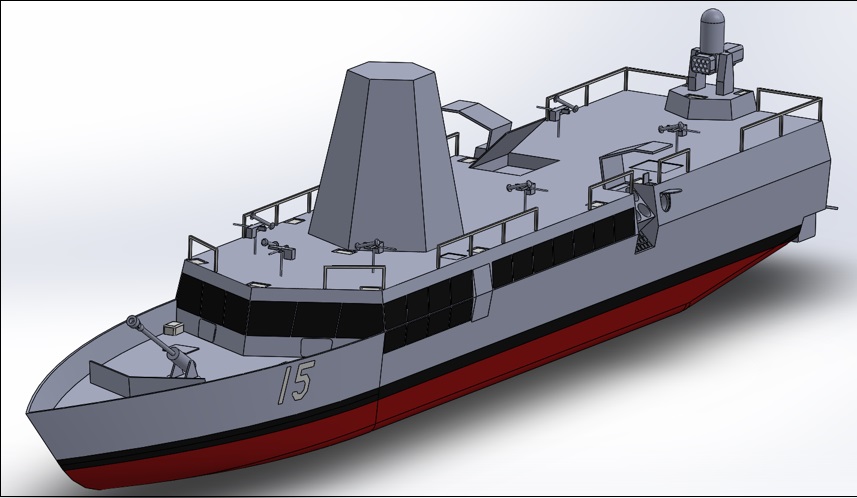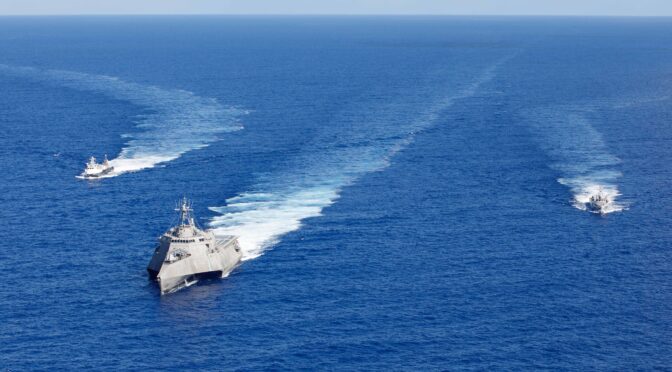By Shelley Gallup
In past wars, small and well-armed ships, such as destroyer escorts, torpedo boats, and riverine craft have been a necessary complement to large combatant force structure. This need is being exacerbated by the U.S. Navy’s currently small yet top-heavy fleet structure. This contrasts with the force structure and operational concepts of Chinese maritime forces, which have been highlighted by the intrusions of PRC naval, Coast Guard, and maritime militia ships into the territorial waters of the Philippines. The Philippine Navy has only three ships to meet these threats, creating demands for U.S. naval presence that is already stretched thin among its relatively few large combatants. China’s numerous small combatants and maritime auxiliary forces would surely have important wartime roles to play as well, and U.S. large combatants may not be available to address these threats.
Innovation in maritime warfare is strategically significant, continuous, difficult to achieve, and must fight its way through an existing paradigm. Often, by the time innovation is adopted, another construct is appearing on the horizon, resulting in a continuous tail-chase. The U.S. Navy continues to push after esoteric technologies, rather than adopting near-term and less costly capabilities. The proposal here, in support of the bi-modal fleet concept featuring a mix of sea denial and sea control vessels, is the LMACC (Lightly Manned Automated Combat Capability) system. This small combatant vessel concept extends autonomy, machine learning, resilient comms, and passive sensor fusion within a cloud shared by a flotilla or other forces.
The bi-modal fleet structure includes a combination of small, crewed, and autonomous systems working as a networked flotilla. The crewed LMACCs and uncrewed autonomous surface vessels can be built and armed for much lower costs and greater capability than the cost of building one or two more destroyers or frigates. In this systems view, it is the holistic flotilla network that is the capability, rather than the individual platform. The uncrewed vessels act as sensors, and the LMACCs serve as decision arbiters and weapons carriers.

LMACC will also serve a critical function in developing future combat leaders. In today’s destroyer-centric surface fleet, platform command opportunities only appear after more than a decade of service. LMACC is intended as an O-3 command, affording naval officers an opportunity to command earlier in their careers and develop critical leadership skills, including initiative, adaptability, and tactical acumen. Autonomous systems will become increasingly important, but cultivating warrior skillsets earlier in careers will be central to victory.
LMACC is the culmination of three years of research and development at the Naval Postgraduate School, via OPNAV N96F sponsorship with the Naval Research Program (NRP). It is now being considered as an Innovation Capstone Program (ICP), for potential transition to an industry partner for prototype acquisition. At an estimated cost of about $100 million per ship, built in small yards, it is much more affordable than other Navy surface combatants, and will invigorate diversification of the shipbuilding industrial base.
Small warships have a long history in the U.S. Navy, and are poised to offer an evolutionary leap in capability. Small, highly automated, lightly crewed, blue water warships will help offset the capabilities of competing fleets and ensure enduring maritime superiority for the U.S. Navy. It is time to fund and build a prototype of the LMACC and its flotilla innovations.
Dr. Shelley Gallup is a retired surface warfare officer. As an Associate Research Professor at the Naval Postgraduate School, Dr. Gallup has spent 25 years assisting the Navy in developing large-scale experiments at sea. His current work includes research in human-machine partnerships, the role of emergence in combat at sea, and leads the small warship LMACC project at NPS.
Featured Image: The Independence-variant littoral combat ship USS Gabrielle Giffords (LCS 10) leads the formation in a photo exercise with the unmanned surface vessels Ranger and the USV Mariner during Integrated Battle Problem (IBP) 23.2, Sep. 7, 2023. (U.S. Navy photo by Mass Communication Specialist 2nd Class Jesse Monford)


Yes we need a new small ship. Read the tea leaves and which way the wind is blowing and work to pull the various in flight parts out there to make it work. Look at the Marines putting NSM and Tomahawk on unmanned JLTVs and their SHORAD on JLTVs and even lighter vehicles. Many targets, hard to find and hit, keeping a viable long range threat at the ready. Please enemy, waste the time and resources coming after this or steer clear. Either way I now have you reacting to me for very little effort on my part.
– Man the MUSV hull. It outperforms any other hull its size on the ocean today while maintaining range and seakeeping. This way we have manned crews familiar with what it can and can’t do out there along with it. Synergy in training and manning.
– Exploit the mk 41 systems for logistics ease with the fleet. The new ADL for ESSM on the carriers is tactical length. Quad pack ER-GMLRS or GLSDB and you now have a cheap, more lethal NGFS method where a 2 billion dollar AAW ship doesn’t have to drive up to the enemy coast to use its pop gun. If you used the whole deck you could fit 10 of these for 40 cells, 160 rounds.
– We could also drop 4 Mk 70 launchers on one and have 16 Tomahawk or SM-6 ready to go for ASuW as a FAC.
– Fit SEWIP Lite with NULKA as basic kit with an RPS-42 fixed face radar and some XM914 turrets with the 30mm air burst rounds for UAS. Those mounts can also mount 2 Stinger or a Javelin. A ship being used elsewhere with gear all being used elsewhere.
If that size hull is absolutely too small, try the FSV Ms. Netty (since renamed). It’s 900 tons and 225 x 36. Basically the size of a Russian Karakurt.
Whatever we do, let’s not let the MIC or Navy design a new ship where they have to select the propulsion plant.
The Navy is decommissioning the Latoral ships that was to fill that need.
Can someone say: Admiral Cebrowski and Streetfighter – https://www.usni.org/magazines/proceedings/1999/november/rebalancing-fleet
What is new is new again? Exactly why the LCS program became such a complete disaster. I honestly give up on the USN and its’ intellectual leadership – not to mention ship design & construction capabilities. Can we say: LCS, DDG-21, Cruiser upgrade and/or replacement, CVN construction, general maintenance, operational leadership (see 2 DDG damaged and 1 Amphibious Warfare ship lost dockside).
The American public (read taxpayers) has not been well served by USN leadership in over 20 years but then again Congress has failed to provide true oversight & guidance because those same voters have not paid attention.
Final Note: During the failed LCS program, a US shipyard actually delivered a ship similar to the original Streetfighter concept in the form of the Ambassador class of FAC(M) for the Egyptian Navy while Denmark designed and built a class of 5 frigates which cost 1/2 as much as the LCS and delivered 4 times as much capability – and became the basis for the soon to be delivered Type 31 Frigate for the Royal Navy and the Arrowhead 140 design being built for Poland and Indonesia. Shame…utter and complete shame.
The Lightly Manned Automated Combat Capabiity (LMACC) takes up where Streetfighter left off. Taking a lead from Prof Jeff Kline and the late WQayne Hughes, it is deeply connected to the former Streetfighter concept. The pursuit of an armed, completely autonomous surface ship is a chimera, for many reasons. LMACC is intended as an evolutionary platform and networked concept that can be built now, at much lower cost than other platforms. Its range, endurance and weaponry, combined with passive sensor grid including other unmanned platforms, allows it to be a deterrent force, forward. Please take some moments to read what is available at the web site (click the link with my name in the article). In addition, this concept is being moved forward outside of the normal USN ship design and program of record PMWs, purposively. As an Innovation Capstone Project (ICP) at the NPS, a transition path will be created, and alternatives to mired acquisition sought.
US Navy strategy must drive force design. The USN does not have an operational level of war strategy and that makes it hard to pursue new ship types outside traditional force design. As of yet, the Navy has not articulated a need for a combatant smaller than LCS size. Some have suggested that the USCG National Security Cutter is about as small as the USN should go in terms of manned warship size. Unmanned ships have additional costs too in terms of the people/bases needed to maintain them. Small/micro-combatant advocates could help their cause if they were to articulate how those units fit into a global maritime strategy and how their weaknesses such as range, lack of air/ASW capability, and need for protected bases can be mitigated. Otherwise the idea of larger ships that are inherently more mobile and sustainable at sea will persist over the idea of smaller, more land-based attack craft.
We have no shortage of forward bases for small ships. we are going to stretch our thin fleet for 2 carriers off Gaza right now. That might be the right response, but its also one of only a few options available. What if we had a flotilla of 600 ton ships from Souda Bay with their own ISR with class II/III UAVs and either 4 x 4 Mk 70 launchers for Tomahawk or potentially 40 cells quad packed with ER-GMLRS using ADL launchers on deck. This is a great option for a low intensity scenario or even as an options to give the big ships a break.
We are going to need every carrier available next year when China presses the go button.